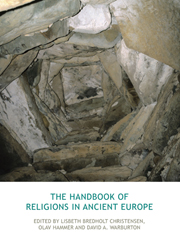Book contents
- Frontmatter
- Contents
- A note on Greek and Latin sources
- Abbreviations and short titles
- 1 Introduction
- PART I PREHISTORIC RELIGIONS
- PART II ANCIENT EUROPE IN THE HISTORICAL PERIOD
- 12 Minoan and Mycenaean religion
- 13 Etruscan religion
- 14 The religions of the Iberian Peninsula
- 15 Italic religion
- 16 Roman religion
- 17 Ancient Greek religion
- 18 The Graeco-Roman cult of Isis
- 19 The cult of Mithras
- 20 Religious Platonism: philosophy and religion in the Platonic tradition
- 21 Insular Celtic religion
- 22 Continental Germanic religion
- 23 Pre-Christian Anglo-Saxon religion
- 24 Old Norse religion
- 25 Slavic religion
- 26 Baltic religion
- 27 Religion in prehistoric Finland
- 28 Sami religion
- Timeline of key dates
- Contributors
- References
- Index
19 - The cult of Mithras
from PART II - ANCIENT EUROPE IN THE HISTORICAL PERIOD
- Frontmatter
- Contents
- A note on Greek and Latin sources
- Abbreviations and short titles
- 1 Introduction
- PART I PREHISTORIC RELIGIONS
- PART II ANCIENT EUROPE IN THE HISTORICAL PERIOD
- 12 Minoan and Mycenaean religion
- 13 Etruscan religion
- 14 The religions of the Iberian Peninsula
- 15 Italic religion
- 16 Roman religion
- 17 Ancient Greek religion
- 18 The Graeco-Roman cult of Isis
- 19 The cult of Mithras
- 20 Religious Platonism: philosophy and religion in the Platonic tradition
- 21 Insular Celtic religion
- 22 Continental Germanic religion
- 23 Pre-Christian Anglo-Saxon religion
- 24 Old Norse religion
- 25 Slavic religion
- 26 Baltic religion
- 27 Religion in prehistoric Finland
- 28 Sami religion
- Timeline of key dates
- Contributors
- References
- Index
Summary
A. D. Nock illustrated the problematic nature of the source materials documenting the cult of Mithras by means of the following analogy (Nock 1964: 58): imagine the situation of scholars of twentieth-century Christianity who had the following materials at their disposal: the plans and designs of a few churches, often with bare and undecorated walls; a few altars and paintings; some fragments of glass windows; a few lists of baptized congregation members; and more than seven hundred images of a person affixed to a cross. There would be major problems in reconstructing Christianity from such fragments, as indeed it is difficult to understand Mithraism from similarly scattered remains.
To Nock's analogy I would like to add yet another: Augustine, in one of his tracts (De haeresibus), discusses a total of eighty-eight different Christian “heresies”. Although Mithraism did not operate with a distinction between “orthodox” and “heretical”, the analogy suggests that we recognize a plurality of diverse developments also within this religion.
The cult of Mithras originated in either Rome or Ostia. Although there is evidence in favour of the idea that a specific person created the cult, an “unknown religious genius” to quote M. P. Nilsson (1974: 675), there is no agreement on the validity of such a hypothesis. Mithraism clearly combines innovative elements with existing traditions: it contains elements familiar from Oriental Hellenistic mystery cults, references to an astrological cosmology and a number of Iranian names and terms, including key concepts such as nama, “salvation”.
- Type
- Chapter
- Information
- The Handbook of Religions in Ancient Europe , pp. 242 - 262Publisher: Acumen PublishingPrint publication year: 2013



